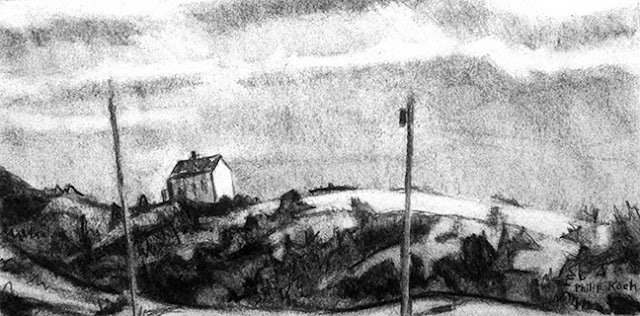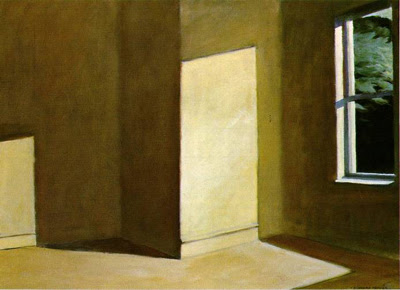Timeless Art? Edward Hopper
This morning I was sorting through files of my early paintings and came across this one.
Philip Koch, Edward Hopper’s Studio, S. Truro, MA,
oil
on paper mounted on panel, 5 ½ x 9 inches, 1997
Sometimes it’s art that
reminds us of the relentlessness of change. I first started staying and working
in Edward Hopper’s Cape Cod studio in 1983.
By 1997 I noticed that the wide open views from the studio that I so loved when I first stayed there were becoming
obscured as the surrounding trees were
growing taller. In my mind the studio standing alone high on its sand
dune had been the very picture of timelessness. But clearly it wasn’t. Wanting to pin down how the
studio had once seemed I did this painting above of how the studio had
appeared the first time I saw it.
Edward Hopper, Hills, South Truro, oil on canvas, 1930
Cleveland Museum of Art
Hopper spent his first his first summer on Cape Cod in 1930, renting a house in the tiny town of Truro. He fell in love with the particular patch of land he depicted above in his oil that's now in the Cleveland Museum of Art. Four years later he would build his studio on top of the ridge at the spot just above the chimneys of the lone house in this painting.
Time doesn't seem to want to stand still for Hopper's subjects- Cleveland Museum's Hopper oil shows at the left the distinctive pyramid-shaped dune that later got bulldozed away by a developer. Hopper had immortalized that now lost natural feature in another oil from 1930, The Camel's Hump, that's one of the stars of the Munson Williams Proctor Arts Institute's collection.
Edward Hopper, The Camel's Hump, oil on canvas, 1930
Munson Williams Proctor Arts Institute, Utica, NY
And the steady erosion of the open spaces Hopper knew continued as now two mega-mansions have been built crowding against the space around the artist's studio.
Here's a photo I took in 2018 of the Hopper studio bathed in
a bright early morning sunlight.
Art can be a poignant reminder of how all of our world is in constant flux. In that way it feels the opposite of timeless. Yet at its core art lets us put our hands on at least for a moment the artist's deeply personal response Touched by a Hopper paining we can feel ourselves right back there standing with the artist. We can feel much of what he was experiencing as he created the piece. It's almost a kind of time travel that grants us a chance to feel from the inside another's intimate inner world. To me that's timeless.






